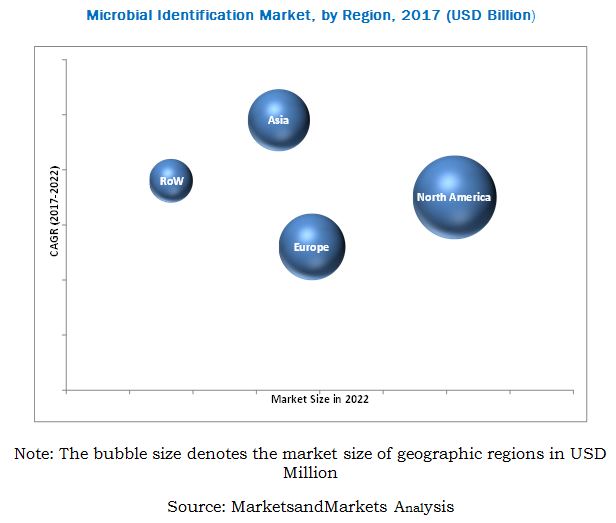The report “Microbial Identification Market by Product & Service (Instruments, Consumables, Identification Services), Method (Phenotypic, Proteomics-based, Genotypic), Application (Pharmaceutical, Diagnostic, Environmental, Food), End User – Global Forecast to 2022″, The microbial identification market is expected to reach USD 3.00 Billion by 2022 from USD 2.18 Billion in 2017, at a CAGR of 6.6%.
Factors driving the growth of this market include increasing incidence of infectious diseases coupled with epidemic and pandemic outbreaks, growing concerns about food safety, innovations in microbial identification techniques, and government initiatives and funding supporting microbial identification.
Instruments are estimated to account for the largest market share in 2017
On the basis of product and service, the microbial identification market is classified into instruments, consumables, and services. The instruments are expected to lead the global microbial identification market in 2017. Factors driving the growth of this segment include the wide use of instruments across applications and technological advancements, which have led to the launch of innovative products.
The phenotypic methods segment is estimated to dominate the market in 2017
By method, the market is segmented into phenotypic, genotypic, and proteomics-based methods. The phenotypic methods segment is anticipated to account for the largest share of the global microbial identification market in 2017. These methods are cost-effective, easy to perform, and can deliver results rapidly. Therefore, they are widely adopted across industries, which is a major factor responsible for the large share of this segment.
View more detailed TOC @
https://www.marketsandmarkets.com/Market-Reports/microbial-identification-market-10702182.html
By end user, the hospitals, diagnostic laboratories, and blood banks segment is estimated to command for the largest share of the market during the forecast period
On the basis of end user, the microbial identification market is categorized into hospitals, diagnostic laboratories, and blood banks; food manufacturing companies; beverage manufacturing companies; pharmaceutical companies and CROs; and other end users. The hospitals, diagnostic laboratories, and blood banks segment is estimated to account for the largest share of the global microbial identification market in 2017. The heavy burden of different infectious diseases, along with periodic outbreaks of pandemic and epidemic diseases are the key factors driving the growth of this end user segment.
North America is estimated to command the largest share of the market
Based on region, the microbial identification market is segmented into North America, Europe, Asia, and Rest of the World (RoW). North America is expected to dominate the microbial identification market in 2017. This is attributed to factors like increasing adoption of microbial identification techniques for research purposes; rising prevalence of infectious diseases; growing incidence of foodborne infections, safety concerns; and technological advancements in microbial identification products in the region as compared to other regions.
Market Players
Dickinson and Company (US), Thermo Fisher Scientific Inc. (US), Danaher Corporation (US), bioMérieux S.A. (France), Merck KGaA (Germany), Charles River Laboratories International, Inc. (US), Bruker Corporation (US) are among a few major players in the microbial identification market.
Discount On Report @ https://www.marketsandmarkets.com/discountreports.asp?id=10702182



